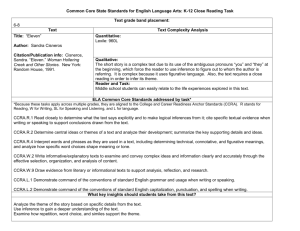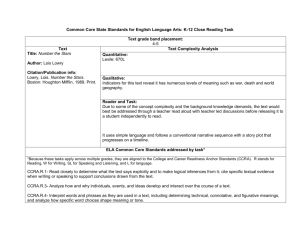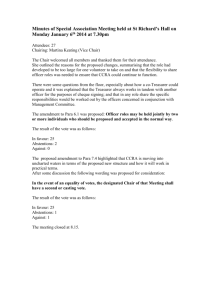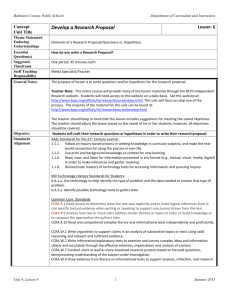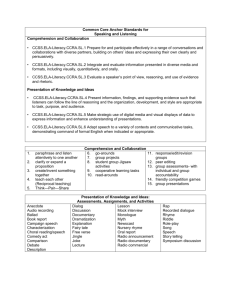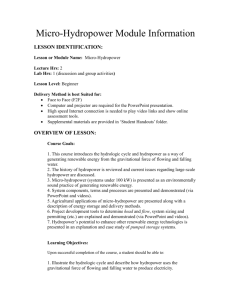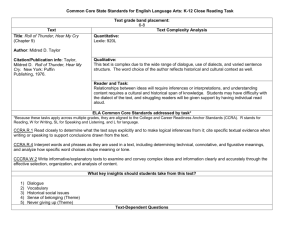Tax Tips & Traps 50
advertisement
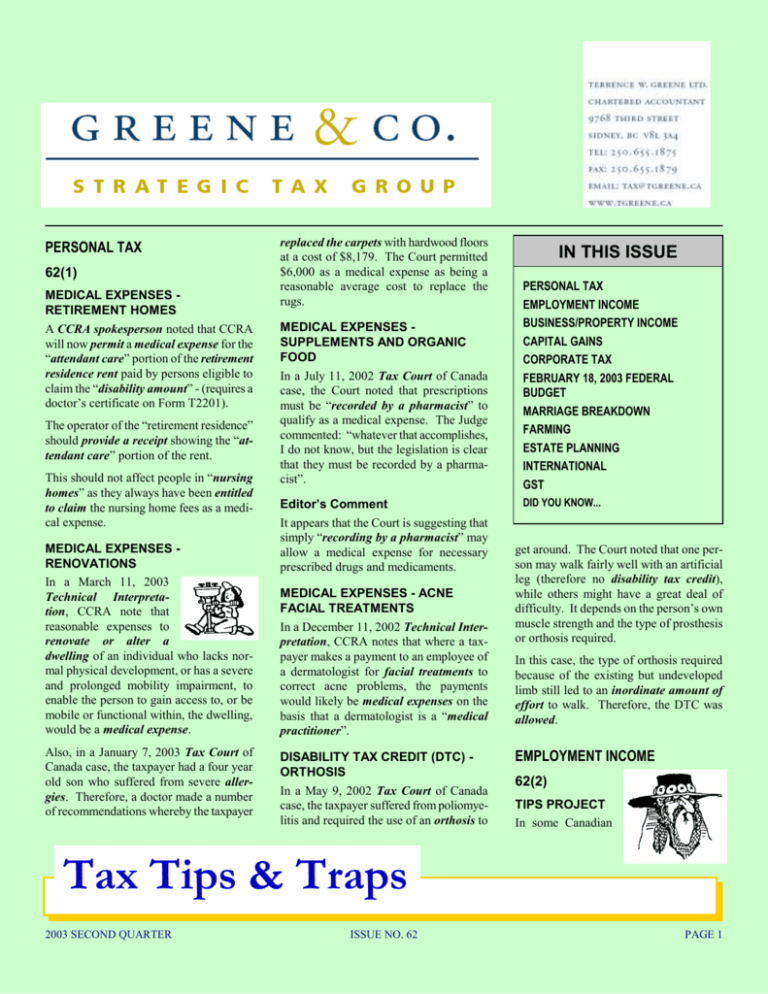
PERSONAL TAX 62(1) MEDICAL EXPENSES RETIREMENT HOMES A CCRA spokesperson noted that CCRA will now permit a medical expense for the “attendant care” portion of the retirement residence rent paid by persons eligible to claim the “disability amount” - (requires a doctor’s certificate on Form T2201). The operator of the “retirement residence” should provide a receipt showing the “attendant care” portion of the rent. This should not affect people in “nursing homes” as they always have been entitled to claim the nursing home fees as a medical expense. MEDICAL EXPENSES RENOVATIONS In a March 11, 2003 Technical Interpretation, CCRA note that reasonable expenses to renovate or alter a dwelling of an individual who lacks normal physical development, or has a severe and prolonged mobility impairment, to enable the person to gain access to, or be mobile or functional within, the dwelling, would be a medical expense. Also, in a January 7, 2003 Tax Court of Canada case, the taxpayer had a four year old son who suffered from severe allergies. Therefore, a doctor made a number of recommendations whereby the taxpayer replaced the carpets with hardwood floors at a cost of $8,179. The Court permitted $6,000 as a medical expense as being a reasonable average cost to replace the rugs. MEDICAL EXPENSES SUPPLEMENTS AND ORGANIC FOOD In a July 11, 2002 Tax Court of Canada case, the Court noted that prescriptions must be “recorded by a pharmacist” to qualify as a medical expense. The Judge commented: “whatever that accomplishes, I do not know, but the legislation is clear that they must be recorded by a pharmacist”. Editor’s Comment It appears that the Court is suggesting that simply “recording by a pharmacist” may allow a medical expense for necessary prescribed drugs and medicaments. MEDICAL EXPENSES - ACNE FACIAL TREATMENTS In a December 11, 2002 Technical Interpretation, CCRA notes that where a taxpayer makes a payment to an employee of a dermatologist for facial treatments to correct acne problems, the payments would likely be medical expenses on the basis that a dermatologist is a “medical practitioner”. DISABILITY TAX CREDIT (DTC) ORTHOSIS In a May 9, 2002 Tax Court of Canada case, the taxpayer suffered from poliomyelitis and required the use of an orthosis to IN THIS ISSUE PERSONAL TAX EMPLOYMENT INCOME BUSINESS/PROPERTY INCOME CAPITAL GAINS CORPORATE TAX FEBRUARY 18, 2003 FEDERAL BUDGET MARRIAGE BREAKDOWN FARMING ESTATE PLANNING INTERNATIONAL GST DID YOU KNOW... get around. The Court noted that one person may walk fairly well with an artificial leg (therefore no disability tax credit), while others might have a great deal of difficulty. It depends on the person’s own muscle strength and the type of prosthesis or orthosis required. In this case, the type of orthosis required because of the existing but undeveloped limb still led to an inordinate amount of effort to walk. Therefore, the DTC was allowed. EMPLOYMENT INCOME 62(2) TIPS PROJECT In some Canadian Tax Tips & Traps 2003 SECOND QUARTER ISSUE NO. 62 PAGE 1 cities, including Calgary, CCRA are carrying out projects with respect to unreported tips in the hospitality industry. We understand that CCRA may just go back one year. NON-COMPETE AMOUNTS On March 11, 2003 the Federal Court of Appeal unanimously found that the receipt of a non-competition amount is tax-free. The Court noted that: 1. “No doubt many will consider the result of this case to be unsatisfactory in terms of fiscal policy. I am sympathetic to the view that it seems unfair that the shareholder of a corporation who bargains for a non-competition payment in the context of a sale of the shares is not taxed on the payment, even though in economic terms it may represent the realization of a substantial part of the commercial value of the business of the corporation. However, it is one thing to recognize an unsatisfactory state of affairs, and quite another to repair it.” 2. The payments received under the noncompetition agreements were not proceeds of disposition of property and, are not capital gains, they are taxfree. Editor’s Comment This case may cause the Department of Finance to amend the Income Tax Act to deal with non-competition receipts. Therefore, it may be wise to take advantage of this decision prior to any legislative amendment. COMMISSION SALESPERSON In a November 26, 2002 Tax Court of Canada case, Mr. Gajos was a sales employee of Future Shop Ltd. paid on commission. He was required to sell in the main store as well as do comparison shopping at other stores and attend training sessions. He incurred expenses such as the acquisition of supplies, business cards, day timers, trade publications, as well as vehicle expenses, as confirmed in the Form T2200 signed by the employer. The Court permitted most of the travel expenses and expenses such as advertising, meals, supplies and long distance telephones. BUSINESS/PROPERTY INCOME 62(3) AUTOMOBILE ALLOWANCE In a January 10, 2003 Technical Interpretation, CCRA notes that an employer may pay a reasonable automobile allowance to an employee and deduct up to 41 cents per kilometre for the first 5,000 kilometres and 35 cents for each additional kilometre (45 cents/39 cents for the Yukon Territory, Northwest Territories and Nunavut). Also, these per kilometre amounts will be considered reasonable, and therefore not taxable as employment income. However, CCRA also notes that where the payment exceeds the prescribed amounts, it may still be considered reasonable, and not taxable, given the proper circumstances. An amount will be deemed not to be reasonable unless it is based solely on the number of employment kilometres driven. INTEREST EXPENSE The February 18, 2003 Federal Budget notes that the Department of Finance is not pleased with recent Supreme Court decisions which permit interest expense deductions when personal debt is reorganized into investment debt or, where the interest expense is significantly higher than the income generated. Therefore, the Department of Finance proposes to introduce interest deductibility legislation shortly with a period of public consultation to follow. Editor’s Comment It may be important to restructure debt prior to the Department of Finance introducing new legislation. MUTUAL FUNDS Mutual funds may earn interest income, dividends, foreign interest and capital gains. These types of income retain their character when they are distributed to the investors. Investors holding units of a fund on distribution day must include that amount in income. Trusts distribute income to avoid having the income taxed in the Trust at top tax rates. Therefore, if an investor purchases units of a fund just before it pays a distribution, that person will be required to report all of the income. TAX-FREE RECEIPTS In a 2002 Tax Court of Canada case, IPSCO sued a supplier for additional costs of $7.6 million which they incurred because of the acquisition of a faulty pipe treatment system. IPSCO received an outof-court settlement of $4.8 million. For accounting purposes, IPSCO reduced the cost of the asset but, for tax purposes they showed the $4.8 million as a tax-free receipt. CCRA reassessed on the basis that the asset cost should also be reduced for capital cost allowance purposes. Good News! The $4.8 million was found to be a taxfree receipt with no reduction in the cost of assets acquired. Also, in a November 28, 2002 Federal Court of Appeal case, the taxpayer received $12 million from the City of Toronto on a quasi expropriation of their building - $2.9 million for the land, $.1 million for the building, and $9 million “in respect of damages occasioned as a result of the inability of the appellant to relocate its business”. CCRA argued that the $9 mil- Tax Tips & Traps 2003 SECOND QUARTER ISSUE NO. 62 PAGE 2 lion should be shown as a disposition of eligible capital property with threequarters, or $6.5 million, shown as taxable income. Good News! The Court found that the $9 million was a non-taxable capital receipt. CAPITAL GAINS 62(4) PRINCIPAL RESIDENCE EXEMPTION It is noted on Page 42 of CCRA’s Capital Gains Guide (T4037) that the amount of land that is considered as a tax free principal residence on disposition is usually limited to one-half hectare (1.24 acres). However, if a taxpayer can show that more land was needed to use and enjoy the property, that amount is eligible as a principal residence. For example, if the minimum lot size imposed by a municipality at the time you bought the property is larger than one-half hectare. CAPITAL DIVIDEND ACCOUNT (CDA) If a corporation had taxable capital gains in the three preceding years, the corporation may trigger a capital loss on its loser investments in the current year to be carried back against those taxable capital gains. However, it is important to remember to pay out the CDA on the capital gain before the capital loss is triggered. For example, if a corporation had a capital gain in 2000 of $100, taxable capital gain of $75 and CDA of $25, it is important to elect to pay the tax free $25 CDA before a capital loss is triggered in 2003 which effectively negates the CDA if the CDA is not paid out before triggering the capital loss. CORPORATE TAX 62(5) SHAREHOLDER AGREEMENT DEEMED CONTROL/DEEMED ASSOCIATION The Income Tax Act extends the control and association concepts to situations where a shareholder has a right under a contract, in equity or otherwise, either immediately or in the future and either absolutely or contingently to acquire shares... He/she will be deemed to have owned those shares unless the right is under a death, bankruptcy or permanent disability. In a January 7, 2003 Technical Interpretation, CCRA reviewed a situation where the shares of OPCO were owned by Corporations A, B and C which were subject to the following “cash-call provision”. 1. Under certain circumstances OPCO can issue a demand for cash to each shareholder in proportion to its shareholdings; 2. If a shareholder fails to advance the funds, another shareholder may advance the funds; 3. If the defaulting shareholder fails to repay the advancing shareholder within 90 days, the advancing shareholder may cause OPCO to proportionately reduce the defaulting shareholder’s shareholdings in OPCO. Bad News! CCRA concluded that each corporation would be deemed to own all the shares of the other corporation for control and association purposes. FEBRUARY 18, 2003 FEDERAL BUDGET 62(6) On February 18, 2003, the Honourable John Manley, Minister of Finance, presented his first Budget to the House of Commons. Some of the more important tax changes include: Child Disability Benefit A $1,600 Child Disability Benefit (CDB) for children who meet the criteria for the disability tax credit (DTC). Medical Expense Tax Credit New eligible medical expenses including: Real-time captioning for individuals with a speech or hearing impairment; Note-taking services used by individuals with mental or physical impairments and the cost of voice recognition software used by individuals with a physical impairment as certified by a medical practitioner; and The incremental cost associated with the purchase of gluten-free food for individuals with celiac disease. Registered Pension Plan (RPP) and Registered Retirement Savings Plan (RRSP) Limits The money purchase RPP limit will be increased to $15,500 for 2003, $16,500 for 2004 and $18,000 for 2005. The RRSP limit will be increased to $14,500 for 2003, $15,500 for 2004, $16,500 for 2005 and $18,000 for 2006. Small Business Deduction The small business deduction reduces the basic federal corporate income tax rate to 12 per cent for the first $200,000 of active Tax Tips & Traps 2003 SECOND QUARTER ISSUE NO. 62 PAGE 3 business income of a Canadian-controlled private corporation (CCPC). The annual amount of active business income eligible for the reduced 12-per-cent tax rate will be increased to $225,000 (year 2003); to $250,000 (2004); to $275,000 (2205) and after 2005, to $300,000. Federal Capital Tax Eliminate the .225 per cent federal capital tax over five years, starting January 1, 2004. Resource Taxation Change the taxation of resource income by phasing in, over a period of five years: a reduction of the corporate income tax rate from 28 per cent to 21 per cent; a deduction for provincial and Crown royalties and mining taxes paid and the elimination of the existing 25-per-cent resource allowance; and a new tax credit for qualifying mineral exploration expenditures. MARRIAGE BREAKDOWN 62(7) SPOUSAL SUPPORT MADE AFTER DEATH In a February 26, 2003 Technical Interpretation, CCRA notes that where Mr. A is paying tax deductible support payments to his former spouse (Ms. A), if, upon Mr. A’s death, the Estate is required to continue to make the periodic payments, the amounts will not be deductible to the Estate, or be taxable to Ms. A. RRSP ROLLOVER The Income Tax Act provides for an RRSP rollover from one spouse to the other spouse under a division of property arising on the breakdown of a marriage or common-law partnership. In a favourable 2002 Advance Income Tax Ruling, the taxpayer and the spouse had previously entered into a separation agreement which provided for periodic monthly support amounts. The agreement is to be amended to delete the future support payments and replace them with a transfer from the taxpayer’s RRSP to the former spouse’s RRSP on a rollover basis. CANADA PENSION PLAN (CPP) CREDIT SPLITTING When a relationship ends, the Canada Pension Plan pension credits which the couple built up during the time they lived together can be divided equally between them. SUPPORT PAYMENTS It is noted in CCRA’s Guide Pl02, that if a person wishes to deduct alimony he/she must register their Order or Agreement by completing Form T1158. Also, a payor of alimony may request CCRA to reduce the amount of income tax that an employer is deducting from salary by completing Form 1213 (Request to Reduce Tax Deductions at Source). COMMON-LAW COUPLES The December 20, 2002 issue of the Globe and Mail notes that common-law partners (unlike married couples) do not have a guaranteed right to a 50-50 split of assets when the relationship collapses based on a recent Supreme Court of Canada case. This case involved Susan Walsh and Wayne Bona, a couple who cohabited for ten years and had two children. After the breakup, Ms. Walsh wanted a share of the assets in Mr. Bona’s name. She sought to have Nova Scotia’s Matrimonial Property Act declared unconstitutional because it excluded common-law partners from its definition of spouse. The Court noted that extending the legal consequences of mar- riage to common-law partners would “nullify the individual’s freedom to choose alternative family forms, and to have that choice respected by the state”. REDO THE DEAL It was noted in the October 28, 2002 issue of the National Post that Eric Miglin is appealing an Ontario Court of Appeal Decision to the Supreme Court of Canada. The Ontario Court had ruled that Mr. Miglin’s spouse could reopen their property settlement and alimony agreement if there are material changes and circumstances that would have likely led to a different agreement if they had been known at the outset. In this case, Ms. M got the Toronto home worth $500,000 as well as $60,000 a year to support their four children. Mr. M retained the Killarney lodge which receives millions of dollars annually. The Ontario Court adjusted the agreement to provide Ms. M with an additional $4,400 a month for personal support. This case could affect thousands of divorced couples who would like to redo their Divorce Agreement. FARMING 62(8) SALE OF TIMBER In a December 5, 2002 Tax Court of Canada case, the taxpayers entered into a five-year plan to have trees removed from their farm property. The Court concluded that the gain was capital (not business income) even though the property was not being used for farming. Arguments in favour of “capital” included that the property was originally acquired with the intention of farming, the property had been owned for over forty years and Tax Tips & Traps 2003 SECOND QUARTER ISSUE NO. 62 PAGE 4 there was no timber sold until recently. CCRA’s argument that the amounts should be income on the basis that it was a sale based on production or use, was not correct because it was really a single final transaction transferring all the timber. Also, on January 3, 2003, CCRA introduced new IT-373R2 which discusses the taxation of woodlots including woodlots operated as farms. The criteria needed for capital treatment and capital gain exemption are discussed. SEASONAL AGRICULTURAL WORKERS In February, 2003 CCRA introduced Guide RC4004 - Seasonal Agricultural Workers Program. This Guide discusses how seasonal agricultural workers are taxed, employer withholdings, waivers from withholding tax, transferring a worker to another employer, and the filing of tax returns, and double taxation issues. ROLLOVER TO CHILD In a December 23, 2002 Technical Interpretation, CCRA notes that where farm property is rolled over to an adult child and the property is then sold within a three year period by the child who uses the qualified farm property capital gain deduction, CCRA can deny the tax deferred rollover. NISA FUNDS - NOT SEIZABLE BY CREDITORS It was noted in the December 12, 2002 issue of the Manitoba Co-operator that the Manitoba Court of Appeal ruled that a creditor may not seize the farmer’s NISA account. This overturns a lower court ruling. (Mini G. Enterprises Ltd. vs. Gary and Ron Kendrick) ESTATE PLANNING 62(9) LOAN TO TERMINALLY ILL POLICYHOLDER In a February 25, 2003 Technical Interpretation, CCRA notes that the Financial Services Commission of Ontario has recommended that life insurance companies should provide funds to terminally ill policyholders who have a life expectancy of less than twenty-four months. While not legally obligated to provide funding to these policyholders, many life insurers are considering providing loans to the policyholders out of the insurer’s general funds. SPOUSAL TRUSTS CCRA note in a February 4, 2003 Technical Interpretation that where the income of a spousal trust is payable to the spouse, if the trustee would like the income taxed in the trust an election must be made. Otherwise, the amount must be deductible to the trust and included in income by the spouse. INTERNATIONAL 62(10) U.S. REAL ESTATE SALES The United States imposes taxes on profits on the sale of U.S. real estate by a Canadian under the Foreign Investment in Real Property Tax Act. To enforce collection, a 10% withholding tax is paid to the IRS by the purchaser at the time of purchase. A Canadian person may be exempt from the 10% withholding tax if the selling price is less than $300,000 and the buyer intends to use the property as a “residence”. The buyer must sign an affidavit to this effect. Alternatively, if this exemption is not available, the vendor can apply to the IRS for a reduction in the withholding tax to the maximum possible U.S. tax. Also, some states have a withholding tax on the selling price of real property, including Arizona and Hawaii. The Canadian person then files a U.S. tax return (Form 1040NR - Individual or Form 1120F - Corporation) and shows the withholding tax, if applicable, as a tax installment. A foreign tax credit may be claimed on the Canadian tax return to the extent that the income is taxed on the Canadian tax return. EMIGRATION Individuals who cease to be resident in Canada are deemed to have disposed of property at fair market value with the following exceptions (Subsection 128.1(4)): (i) real property located in Canada; (ii) property used in a business carried on through a Canadian permanent establishment; (iii) certain “rights and interests”, such as pension and deferred income plans, RPPs, RCAs, RRSPs, RRIFs, CPP, OAS, etc.; (iv) employee stock options; and (v) where the individual was resident in Canada for 60 months or less in the last 120 months before leaving Canada, any property owned by the individual when the individual last moved to Canada or inherited during the period of residency. The emigrating individual may defer payment of the tax on the capital gain by posting security with CCRA. However, security is not generally required on the first $50,000 of taxable capital gains resulting from the deemed disposition. Tax Tips & Traps 2003 SECOND QUARTER ISSUE NO. 62 PAGE 5 TRANSFER PRICING It was noted in the December 30, 2002 issue of the Financial Post that about 85% of Canada’s top sixty firms, and more than half of the largest three hundred firms listed on the Toronto Stock Exchange, use some form of transfer pricing, possibly with the intent of transferring profits outside of Canada. For example, a T-shirt costing $1 to make may be manufactured in a tax haven country and sold to a Canadian subsidiary for, say, $10 and then subsequently sold so that the $9 profit is earned outside Canada. Therefore, CCRA has added 40 new auditors to the International Tax Department, bringing a total of 278, whose job it is to ensure that cross-border transfer pricing is correct and that profits are not being transferred outside of Canada. This is the “number 1” issue of CCRA’s International Taxation Department. Therefore, most accountants are advising clients to review their transfer pricing policies in light of this recent CCRA attention. GST 62(11) SORRY - NO ITC In an August 26, 2002 Tax Court of Canada case, Alexander Nix Group Inc. purchased supplies from 864116 Ontario Ltd. (864). After being provided with a GST registration number from 864, the appellant paid $3,766 GST on $53,874 of services and then claimed the $3,766 input tax credits (ITCs). The registration number that 864 provided was the company’s original GST number but was invalid as it had been deregistered years earlier. The Court denied the ITC. The primary reason was because it was deemed the appellant’s responsibility to obtain a valid GST registration number. benefits. INTERNET SUPPLIES In December, 2002 CCRA released a number of Rulings that discuss GST on internet supplies to non-residents. VOLUNTARY DISCLOSURE On June 12, 2002, CCRA issued its revised Voluntary Disclosure Program (VDP) including the introduction of a policy to make a “no-name” disclosure on Form VDP-1. The no-name disclosure does not identify the name of the taxpayer but should be complete and include all relevant information to permit the CCRA officer to review the situation. For example, Ruling No. 33017 (August 16, 2002) notes that job search videos which may be viewed by Canadians and non-residents are considered to be “made in Canada” and, therefore subject to GST. However, this may not be the case had access been limited to non-resident customers. In another Ruling No. 32713, CCRA Ruled that GST must be charged by an internet radio station on fees received for advertising various musician services as this is considered to be supplied in Canada. In another Ruling 32742, CCRA Ruled that digitized artwork available to residents and non-residents of Canada would be considered to be supplied in Canada. KEEP THE INVOICES One of the major reasons for GST reassessments is improper input tax credit documentation. CCRA GST auditors require proper invoices to support input tax credits. For example, if the input tax credit is supported merely by a credit card slip, and not the invoice, it may not be allowed. The source document should show the supplier’s GST registration number. This is not available on credit card receipts, bank statements, and cancelled cheques which, some clients, use as substantiation for their input tax credits. REMITTING GST ON TAXABLE BENEFITS GST must be remitted on an employee taxable benefit unless the benefit is zerorated or tax exempt - such as the benefit on low-interest loans. Taxable benefits that are not exempt include automobile standby charges and operating expense The taxpayer would then proceed with a full disclosure by a negotiated deadline, or alternatively choose not to follow the Voluntary Disclosure process. This Program is administered by CCRA’s Appeals Division. DID YOU KNOW... 62(12) WEB TIPS 1. Financial Advice, Rates and Comparisons If you want information on finances, this site contains several useful tools, including mortgage amortization calculators, mortgage rate comparisons (updated daily), rent vs. own calculators, retirement calculators, and many more. (http://finance.canada.com/bin/putfo rm?Type=Calculator or go to http://finance.canada.com and click on the “calculators” button) This website is hosted by CanWest Global Communications Corp. (National Post, Global TV etc.) 2. Canadian Retirement Income Calculator https://srv260.hrdcdrhc.gc.ca/ or go to www.hrdc.gc.ca and search for “Canadian Retirement Income Calculator”. Hosted by H.R.D.C., this calculator provides a forecast of annual pre-tax Tax Tips & Traps 2003 SECOND QUARTER ISSUE NO. 62 PAGE 6 retirement income. With the use of a seven module procedure, this tool allows users to manipulate most conditions that affect C.P.P. (i.e. taking it early or reducing the number of years paid into the plan), O.A.S., employer pensions, RRSP, and other income amounts. Once the appropriate information is entered, a summary may be printed. One may then change pieces of previously entered data and print out the new summary sheet for comparison. SPOUSAL C.P.P. SPLITTING It is possible for spouses and common-law partners to adjust their CPP receipts so that each person receives half of the pension earned for the years when the two partners were together. To make this “assignment” each partner must be at least sixty years old. This may significantly reduce income taxes if CPP income is shifted to a lower income spouse. CHILD REARING DROP-OUT PROVISION - CPP It is noted in the Human Resources website (www.hrdc.gc.ca) that where a person left the labour force and had a child under the age of seven, these years may be excluded in the calculation of the CPP benefits. This has resulted in refunds to many persons who have been receiving their CPP benefits but are only now advising HRDC of their children. To apply, the child’s birth or baptismal certificate will be needed. For further information contact 1-800-277-9914. WEST AFRICAN/NIGERIAN FRAUD LETTERS Over the past few years, fraudulent letters claiming to originate in Nigeria and other West African nations have been received by individuals. Recently, there has been a resurgence in these letters in an email form. Generally, these letters implore the receiver to take part in a currency transfer plan where the receiver is promised rewards amounting to millions of dollars. The intent of the sender is to abstract money from the receiver in advance in the form of items such as unforeseen taxes, banking fees, and administration fees. If you receive a letter or proposal that has these characteristics or is somewhat questionable, contact “Phonebusters” (operated by the Ontario Provincial Police) for more information at 1-888-495-8501, email: wafl@phonebusters.com, web: http://www/rcmp-grc.ca/scams/nigerian. The website also includes valuable information about other telemarketing scams, how to spot a scam, how to report a fraud and information on charges, arrests, counts and sentencing. The preceding information is for educational purposes only. As it is impossible to include all situations, circumstances and exceptions in a commentary such as this, a further review should be done. Every effort has been made to ensure the accuracy of the information contained in this commentary. However, because of the nature of the subject, no person or firm involved in the distribution or preparation of this commentary accepts any liability for its contents or use. Tax Tips & Traps 2003 SECOND QUARTER ISSUE NO. 62 PAGE 7
